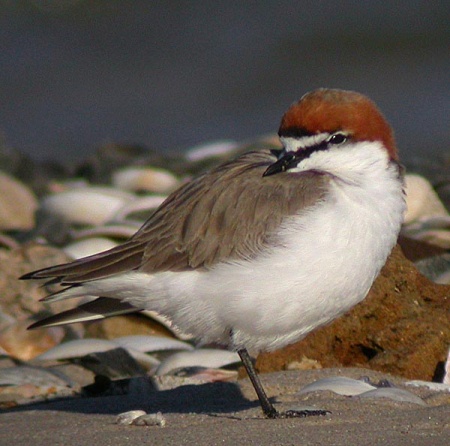(→External Links: Additional GSearch for common name, GSearch checked template) |
|||
| Line 1: | Line 1: | ||
[[Image:Red-capped_Plover.jpg|thumb|450px|right|Male<br />photo © by {{user|Neil|Neil Fifer}}<br />Sydney, [[Australia]]<!--EDiTORS: This image does not appear in the Gallery-->]] | [[Image:Red-capped_Plover.jpg|thumb|450px|right|Male<br />photo © by {{user|Neil|Neil Fifer}}<br />Sydney, [[Australia]]<!--EDiTORS: This image does not appear in the Gallery-->]] | ||
| − | ;[[:Category: | + | ;[[:Category:Anarhynchus|Anarhynchus]] ruficapillus |
| + | ''Charadrius ruficapillus'' | ||
| Line 28: | Line 29: | ||
'''Voice'': a sharp ''tink'' and faint trills. | '''Voice'': a sharp ''tink'' and faint trills. | ||
==References== | ==References== | ||
| − | #{{Ref- | + | #{{Ref-Clements6thOct23}}#Handbook of the Birds of the World Alive (retrieved August 2016) |
{{ref}} | {{ref}} | ||
==External Links== | ==External Links== | ||
| Line 40: | Line 41: | ||
<br /> | <br /> | ||
| − | [[Category:Birds]][[Category: | + | [[Category:Birds]][[Category:Anarhynchus]] |
Revision as of 11:25, 6 January 2024
- Anarhynchus ruficapillus
Charadrius ruficapillus
Identification
14–16 cm (5½-6¼ in); a small plover
- White body
- Brown wings
- Reddish-brown cap
- Dark eye stripe, lores and frontal bar
- White supercilium
The female is similar, but the cap is much diminished to just a brow and reddish-brown tints around the face.
Distribution
Throughout Australia (except arid areas) and Tasmania.
Taxonomy
This is a monotypic species[1].
Habitat
Mostly coastal; found on sandy/shell beaches with nearby mudflts. River edges and lakes inland.
Behaviour
Breeding
Breeds Sep. - Jan. Nest depression in soil or sand lined with shell, stones or vegetation. Eggs 2-3 pale green spotted.
Diet
Diet consists of insects larvae, small crustaceans also some seeds.
Vocalisation
'Voice: a sharp tink and faint trills.
References
- Clements, J. F., P. C. Rasmussen, T. S. Schulenberg, M. J. Iliff, T. A. Fredericks, J. A. Gerbracht, D. Lepage, A. Spencer, S. M. Billerman, B. L. Sullivan, and C. L. Wood. 2023. The eBird/Clements checklist of Birds of the World: v2023. Downloaded from https://www.birds.cornell.edu/clementschecklist/download/
- Handbook of the Birds of the World Alive (retrieved August 2016)
Recommended Citation
- BirdForum Opus contributors. (2025) Red-capped Plover. In: BirdForum, the forum for wild birds and birding. Retrieved 12 May 2025 from https://www.birdforum.net/opus/Red-capped_Plover
External Links
Search the Gallery using the scientific name:
Search the Gallery using the common name:
GSearch checked for 2020 platform.






